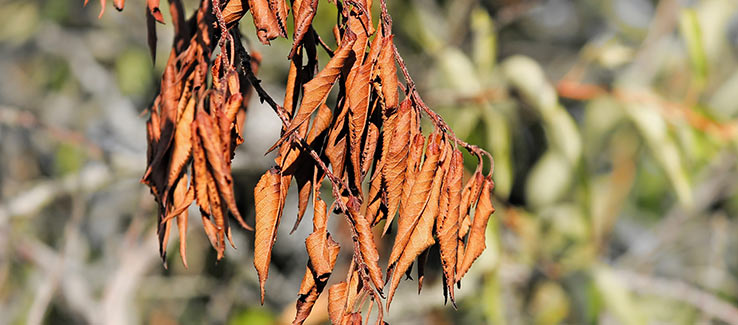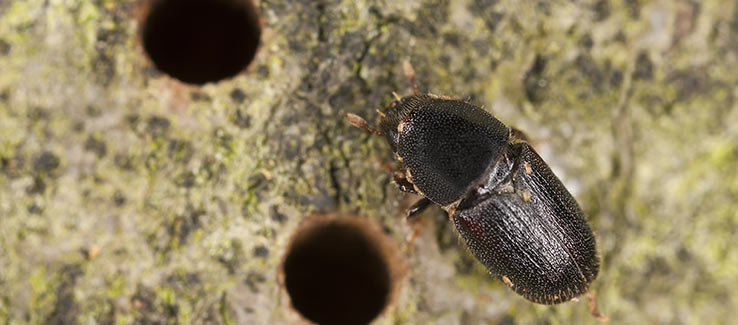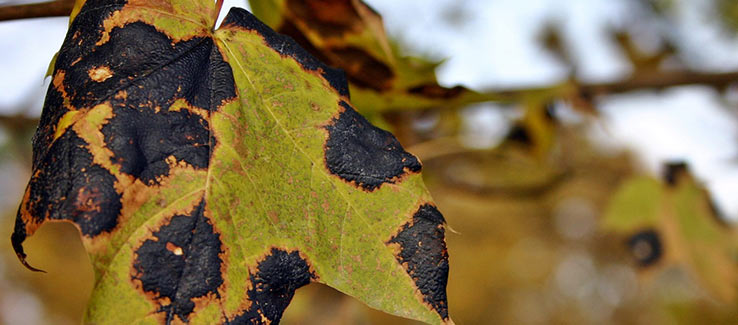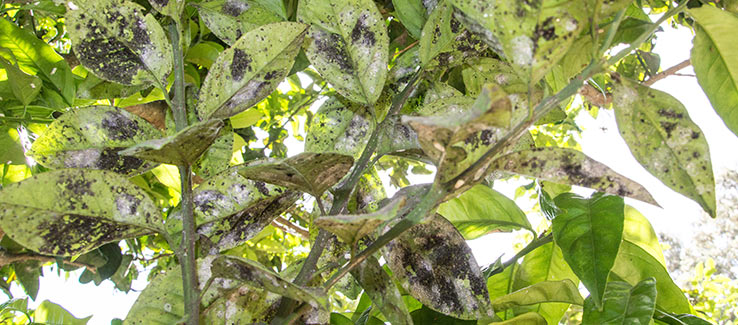Why Are My Tree’s Leaves Turning Black?
Don’t let your tree die when its leaves start turning black. Knowing what causes leaves to turn black and drop can help you spring into action, saving your tree and protecting your landscape.
fasttreeremovalatlanta.com gathered the information why, and steps to take when your tree’s leaves start turning black and falling off your tree.
Why Do Tree Leaves Turn Black?
There are many reasons your tree’s leaves can turn black and fall off the tree. The following are some of the more probable causes:
Hot Weather and Drought – During times of drought, trees are more susceptible to being damaged by radical changes in temperature.
Sudden rises in temperature can leach the moisture out of your trees and cause its leaves to wither, brown, and blacken.

While it isn’t feasible to control the weather, you can help your trees survive radical temperature fluctuations by doing the following:
• Increase the frequency of deep watering
• Decrease the amount of fertilizer applied
• Mulch your trees
During times of drought coupled with high temperatures, your tree’s internal processes speed up. Over-fertilizing may cause your trees to consume more nutrients than they can process, causing fertilizer burn and hastening their death.
Learn more about how to fertilize trees by reading fasttreeremovalatlanta.com/fertilization-basics-healthier-trees
Boring Insect Infestations – When trees are stressed by hot weather, disease, or poor care practices, they become highly susceptible to successful insect attacks. Namely, beetle attacks.
Beetle infestations often result in leaf wilt, severe defoliation, and the blackening of the leaves. When a tree or stand of trees falls victim to a beetle infestation, treatment must begin immediately to slow or halt an infestation of epidemic proportions.
Some of the signs of a successful beetle infestation include:
• Unseasonal leaf color change
• Premature leaf drop
• Crown wilting
• Blackening of the foliage
• Entry holes
• Sawdust found on limbs and trunk

Infested trees are challenging to treat without killing the tree itself, and should be left to a tree professional. However, unaffected trees in the vicinity should be treated with insecticides to deter beetle attacks.
Ash trees are highly vulnerable to the deadly emerald ash borer. However, when their foliage blackens, it is more likely from an anthracnose infection than the borer.
NOTE: It is common practice to remove and destroy heavily beetle-infested trees to protect a wooded area or stand of healthy trees. In some instances, uninfected diseased trees that have become susceptible to beetle infestations may also be removed to prevent the spread of the beetle.
The ambrosia beetle is another boring insect that affects many tree species throughout North America. Learn more about the damage it causes and how to treat an infestation by reading fasttreeremovalatlanta.com/ambrosia-beetle-damage-treatment
Anthracnose Tree Disease – This disease is often referred to as leaf spot or leaf blight. It may be caused by several different fungi. The following are some of the common symptoms indicating that your tree is infected:
• Irregular dead spots on leaves
• Formation of cankers on twigs, branches, and the trunk
• Wilting and blackening of affected foliage
• Premature leaf drop
• Bud death (resembling frost damage)

Treatment for anthracnose includes the systematic application of fungicides in late winter and early spring, and the extensive pruning of affected areas of the tree.
Diseases like anthracnose are easily transmitted from one tree to another, usually by splashing water, overhead watering, and rainwater. Another common form of transmission is through the gardening and pruning tools used for your landscaping. Read about disease prevention tips at fasttreeremovalatlanta.com/5-tree-shrub-disease-prevention-tips
NOTE: Any time more than 25% of a tree’s crown must be pruned, call in a professional tree service to evaluate the health of the tree and potential alternatives to pruning.
Anthracnose is rarely lethal to mature trees. Still, repeated annual infections can cause the decline of the tree’s health, leading to infestations, disease, and the eventual death of the tree.
For more information on identifying and managing anthracnose, visit ipm.ucanr.edu/PMG/PESTNOTES/pn7420.html
Tree Health and Disease Prevention
There are insecticides, fertilizers, and fungicides that can be applied throughout the year to protect your trees. However, the most effective measure to take in preventing your trees from withering in the heat, succumbing to boring insects, or contracting lethal diseases is to promote their health relentlessly.
The following are measures you can take to promote the healthy growth of your trees:
• Conduct annual soil tests to determine nutrient deficiencies and pH adjustments
• Adjust your watering schedule to keep the soil moist but well-drained
• Maintain organic mulch over the root plate throughout the year
• Correctly prune your trees to encourage spring growth
• Have your trees and landscape inspected annually by a professional tree service to detect any potential issues.
Your vigilance in keeping your trees healthy is perhaps their greatest ally in reaching maturity and living their lives pest and disease-free.
When Tree Leaves Turn Black
In this article, you discovered why tree leaves can turn black, and the steps you can take to help your tree recover and prevent future occurrences.
When problems arise, and they will, your immediate response is fundamental to the preservation of a robust landscape filled with healthy trees.
Your inaction or indifference will result in the decline of your tree’s health, its eventual death, and the potential to fall on your property or cause severe injuries.
Sources:
extension.psu.edu/anthracnose-on-shade-trees
entomology.ca.uky.edu/ent43
ipm.ucanr.edu/QT/treeborerscard.html
(404) 220-9965
(404) 220-9963

